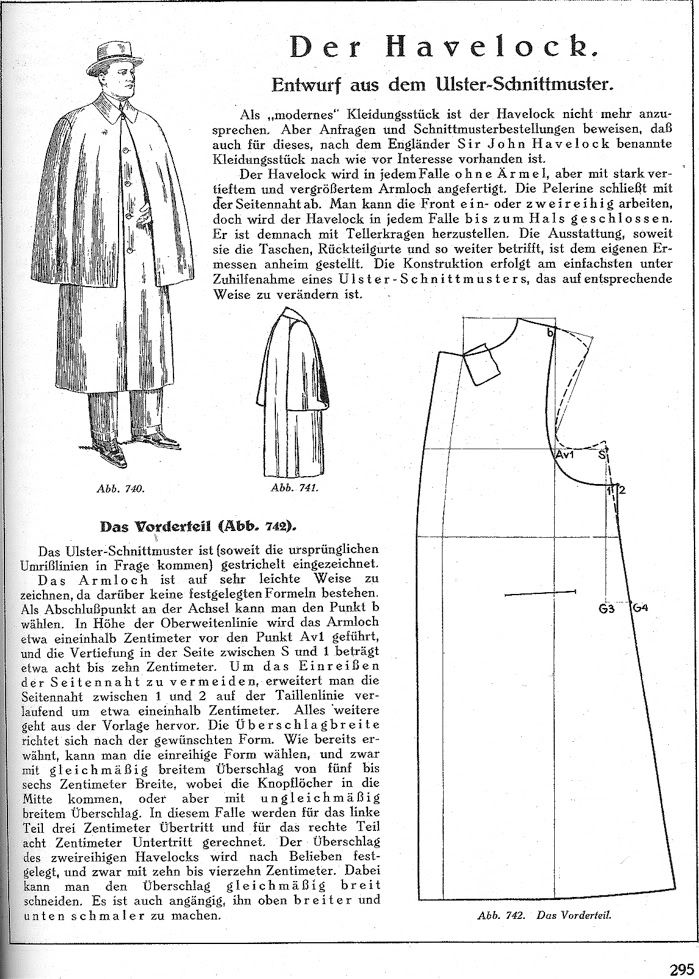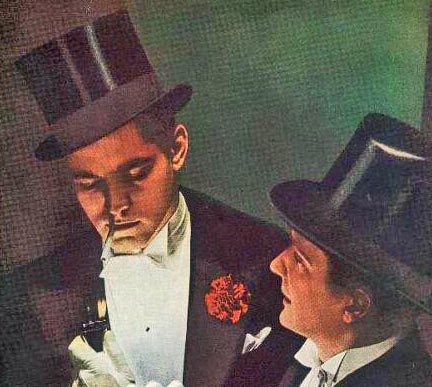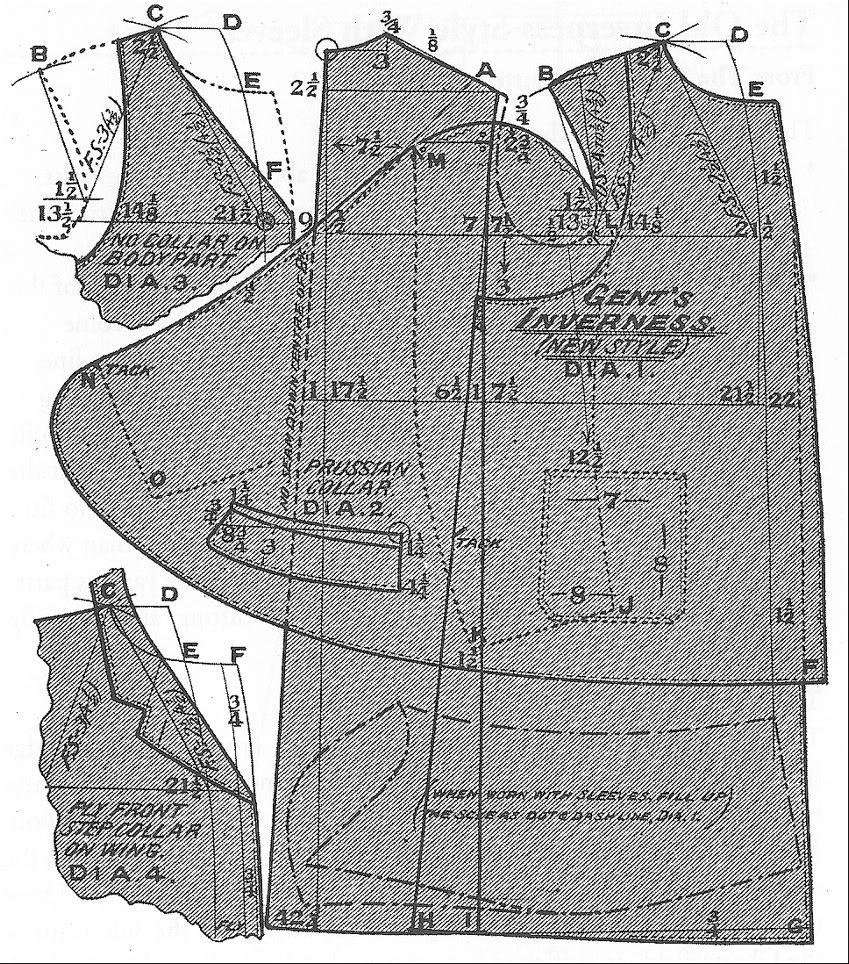So, then, this is a heedless generalization?Anonymous wrote:The Inverness by definition lacks sleeves under the cape/wings. There is no such thing as a sleeved Inverness cloak.Anonymous wrote:Isn't the real point that le gentleman was making is that there was a version without top coat arms betneath the cape or wings?
If an overcoat had sleeves and full cape it would be called a caped Ulster.
Ulster Overcoat
-
Guest
-
Guest
If an Inverness may have sleeves, what then remains its vital distinguishing feature from an Ulster?Anonymous wrote:I have found this one pattern which includes details for a sleeve:Anonymous wrote:Let me muddy the waters a bit more. In my readings (no reference at the moment) was mention that an inverness could have "semi attached" sleeves, permitting the wearer to use them or not as desired.
Note the sleeve outline with the words "when worn with sleeves fill up the scye as dot and dash line".
It is by far and away the exception and the only one amongst about 6-8 patterns that show this novelty detail. All of the others are sleeveless.
Sator
-
Guest
That it's worn by Scotsmen and not by Irishmen?
Seriously, I'd agree with a previous poster -- "pbc"? -- in this thread: terms in actual use are elastic. This troubles me as an amateur of philology (forgive the redundancy!), but it's reality.
Nevertheless, for myself, I'll strive to make the sleeved-sleeveless difference when speaking of "Ulsters" and "Invernesses". Not that I'll have much opportunity to!
RWS
Seriously, I'd agree with a previous poster -- "pbc"? -- in this thread: terms in actual use are elastic. This troubles me as an amateur of philology (forgive the redundancy!), but it's reality.
Nevertheless, for myself, I'll strive to make the sleeved-sleeveless difference when speaking of "Ulsters" and "Invernesses". Not that I'll have much opportunity to!
RWS
-
Guest
Ulsters don't usually have capes - certainly not modern ones. When they did, they were removable - likewise when they had hoods.Anonymous wrote:.
If an Inverness may have sleeves, what then remains its vital distinguishing feature from an Ulster?
The Inverness, in the vast majority of descriptions, remains a sleeveless garment. Usually they have wings that are stitched in rather than a full cape (although many authors call the wings a 'cape').
-
Guest
But is this the case with the Havelock Ulster?Anonymous wrote:Ulsters don't usually have capes - certainly not modern ones. When they did, they were removable - likewise when they had hoods.Anonymous wrote:.
If an Inverness may have sleeves, what then remains its vital distinguishing feature from an Ulster?
The Inverness, in the vast majority of descriptions, remains a sleeveless garment. Usually they have wings that are stitched in rather than a full cape (although many authors call the wings a 'cape').
-
Guest
I searched my pattern books for the overcoats named in this thread.
The Ulster overcoat is always DB with a few variations regarding width and details in the back(like a belt). One book describes a similar model as a travelling overcoat made of Ulster cloth.
Regarding the Havelock and/ or Inverness: One book calls that form simply Havelock(sleeveless overcoat with a cloak/ pelerine), which was made in many variations, without giving them specified names.
The Havelock was ment to be the formal (evening wear) version. The difference being the length of the cloak/ pelerine, which was longer on the Havelock. The Inverness had to have a peak lapel. It can be DB as well.
Both do not have any sleeves.
The more fitted version of an Ulster is the Ulster paletot.
There is another form available, which is called "Schlüpfer" or Slipon. These overcoats had either 2 piece set-in sleeves or raglan and usually a covered buttoning.
I shall post patterns for all those models soon.
SG
The Ulster overcoat is always DB with a few variations regarding width and details in the back(like a belt). One book describes a similar model as a travelling overcoat made of Ulster cloth.
Regarding the Havelock and/ or Inverness: One book calls that form simply Havelock(sleeveless overcoat with a cloak/ pelerine), which was made in many variations, without giving them specified names.
The Havelock was ment to be the formal (evening wear) version. The difference being the length of the cloak/ pelerine, which was longer on the Havelock. The Inverness had to have a peak lapel. It can be DB as well.
Both do not have any sleeves.
The more fitted version of an Ulster is the Ulster paletot.
There is another form available, which is called "Schlüpfer" or Slipon. These overcoats had either 2 piece set-in sleeves or raglan and usually a covered buttoning.
I shall post patterns for all those models soon.
SG
-
Guest
It is the other way around in two of my German texts. "Der Inverneß" is the name given to the formal evening wear version and "der Havelock", that given to the day wear version. From Die Zuschneidekunst Herrenkleidung:Anonymous wrote: Regarding the Havelock and/ or Inverness:
The Havelock was ment to be the formal (evening wear) version. The difference being the length of the cloak/ pelerine, which was longer on the Havelock. The Inverness had to have a peak lapel. It can be DB as well.
SG


Müller also uses the names in the same manner. Müller gives a pattern for a single breasted "Inverneß" and calls the double breasted day wear version a Hohenzollernmantel.
English text do not specify different lengths of the wing for day and evening versions.
Sator
-
Guest
Yes, it is correctly worn indors only! But, if you are a man that makes his own style - you may take it anywhere you please, in which case it is worn with standard issue Havenot suit, tie, shirt and boxers. That will get you to experience the newest model of the Havelock, in no time and free of charge
Costi
-
Guest
When I went through my magazines I found 2 images of coats that might do the trick, given the right cloth and colour.
This first one belongs to the pattern category called paletot, this model I think is a Chesterfield:


The second one is the more waisted type of an Ulster, called the Ulster-Paletot:


According to my pattern books, the Paletots are just slightly larger/wider than coats, whereas overcoats(Mäntel) like the Ulster are cut to be sort of more spacious.
SG
This first one belongs to the pattern category called paletot, this model I think is a Chesterfield:


The second one is the more waisted type of an Ulster, called the Ulster-Paletot:


According to my pattern books, the Paletots are just slightly larger/wider than coats, whereas overcoats(Mäntel) like the Ulster are cut to be sort of more spacious.
SG
-
Guest
-
- Information
-
Who is online
Users browsing this forum: No registered users and 0 guests



